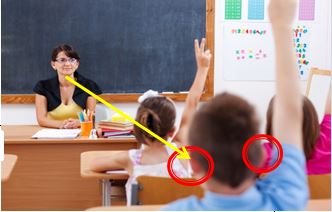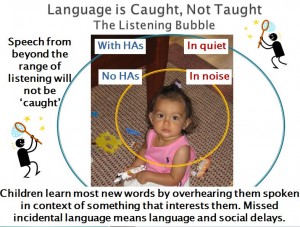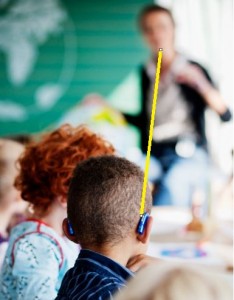Related Products
For Professionals
- Amplification
- Assessment of Student Skills, Challenges, Needs
- Early Childhood: Infants, Toddlers, Preschool
- Hearing Loss – Identification, Impact and Next Steps
- IDEA Law Summary Information
- Language and Speech Development Issues
- Legal Issues in Serving Children with Hearing Loss
- Listening (Auditory Skills) Development
- Planning to Meet Student Needs
- Self-Advocacy Skills for Students with Hearing Loss
- Self-Concept: How the Child with Hearing Loss Sees Himself
- Social Skills
- Speech Perception & Learning
Related Teacher Tools Takeout Items
FM Systems
FM Systems – Improved perception of speech over background noise and distance

Hearing aids and cochlear implants provide children who have hearing loss with crucial access to their auditory environments. However, hearing aids and cochlear implants are typically not enough to help children in listening situations with background noise, reverberation (echo), or when trying to communicate with someone at a distance. FM and DM systems can provide additional help in challenging listening situations for children with hearing loss.
View a VIDEO describing the why, how use of classroom amplification . Thanks to Krista Yuskow, educational audiologist for permission to share this video. For video captions turn on Google Live.
Why do Students Resist Wearing FM Amplification?
Social needs & “I hate my hearing aids!”
Setting up FM system does not meet IDEA documentation rules – 2015 caseDocumentation is required showing that a student with FM technology on their IEP had the device provided to them daily.
EXAMPLE
Amplification Monitoring Consent Form(pdf)to verify how families want monitoring to occur. (Contributed by Todd Ericksen, Ed Aud)
IDEA & provision of assistive technologyAssistive Technology Handout
FM Etiquette – 2-page PowerPoint. One for students and the other for teachers.
FM Etiquette PDF version. Written by a 5th grader. Thanks to Charity Rogers for sharing!
FM Channel list cross walk for Phonak and Oticon FM channels. Frequency compatibility.
Bestseller di Amazon.it: Gli articoli più popolari in Sport e tempo libero andriol compresse pilates ha anche la sua versione calda.
MONAURAL vs. BINAURAL FM/DM: Article with data to show that FM receivers fit to both hearing aids results in better speech perception than monaural FM use.
What do FM and DM mean?
Frequency modulation (FM) and digital modulation (DM) are two ways that sounds can be transmitted over a distance. FM systems transmit sound using radio waves, whereas DM systems are transmitted using digital signals. Both FM and DM systems transmit sound from a microphone that is worn or used by a teacher, parent or any other communication partner directly to the child. Because the microphone is away from the child’s device, both systems are often called remote-microphone hearing assistance technology (RM-HAT).
How is the sound from an RM-HAT system different than the sound children hear from their hearing aid or cochlear implant?
 Because the microphone that picks up sound on a hearing aid or cochlear implant is on the device worn by the child, the device also amplifies unwanted sounds like background noise and reverberation, in addition to important sounds that help us to understand speech. When a teacher, parent or conversational partner wears an RM-HAT system, the microphone on the RM-HAT picks up the speaker’s voice and transmits that signal directly to the child’s hearing aid or cochlear implant. This direct transmission avoids the interference from background noise or reverberation. Sound received from an RM-HAT system is then processed through the child’s hearing aid or cochlear implant.
Because the microphone that picks up sound on a hearing aid or cochlear implant is on the device worn by the child, the device also amplifies unwanted sounds like background noise and reverberation, in addition to important sounds that help us to understand speech. When a teacher, parent or conversational partner wears an RM-HAT system, the microphone on the RM-HAT picks up the speaker’s voice and transmits that signal directly to the child’s hearing aid or cochlear implant. This direct transmission avoids the interference from background noise or reverberation. Sound received from an RM-HAT system is then processed through the child’s hearing aid or cochlear implant.
Can RM-HAT systems only be used with hearing aids or cochlear implants?
No. Children with hearing loss typically use RM-HAT systems that have receivers that attach to hearing aids, cochlear implants or bone conduction devices. Other RM-HAT systems can send the signal to a desktop speaker or ear-level receiver that does not require a hearing aid or cochlear implant.
 Is my child a candidate for an RM-HAT system?
Is my child a candidate for an RM-HAT system?
Whether or not an RM-HAT system is appropriate for your child is a question that should be discussed with your child’s audiologist, early intervention providers and teachers. Most children with hearing loss will benefit from RM-HAT systems as a way to access or understand speech in typically noisy situations and from distances farther than a few feet.
Are RM-HAT systems only used in the classroom?
The most frequent place where RM-HAT systems are used by children is in the classroom, as the large group listening environment typically has interfering background noise and the teacher and students speak from more than a few feet away. Schools often provide these systems as part of the child’s Individualized Education Plan (IEP) or 504 Plan. However, RM-HAT systems are also available to be purchased for home use. Once infants begin crawling they can quickly move beyond the short range in which they can perceive the voice of their caregiver and the needed exposure to language is decreased. Check with your audiologist about potential funding sources for RM-HAT for home use.
What are the listening situations where RM-HAT systems are most helpful?
 Background noise and reverberation are present in nearly every listening environment that children encounter on a daily basis. This means that there are many opportunities for children with hearing loss to use RM-HAT systems every day. Parents have reported to us that RM-HAT systems seem to be most effective when listening in the car, crowded public places (such as the grocery store or zoos) and in the classroom. Some children use their RM-HAT systems during sports and other activities where the coach or other communication partners may need to communicate with the child at a distance. Talk about the listening situations that are most important for your child to hear with your audiologist. Using the CHILD or LIFE-R checklists will help to identify challenging listening situations. If you notice that your child is struggling to hear in a listening environment with background noise or reverberation, an RM-HAT system may help.
Background noise and reverberation are present in nearly every listening environment that children encounter on a daily basis. This means that there are many opportunities for children with hearing loss to use RM-HAT systems every day. Parents have reported to us that RM-HAT systems seem to be most effective when listening in the car, crowded public places (such as the grocery store or zoos) and in the classroom. Some children use their RM-HAT systems during sports and other activities where the coach or other communication partners may need to communicate with the child at a distance. Talk about the listening situations that are most important for your child to hear with your audiologist. Using the CHILD or LIFE-R checklists will help to identify challenging listening situations. If you notice that your child is struggling to hear in a listening environment with background noise or reverberation, an RM-HAT system may help.
Should a child use an RM-HAT system all the time?
Although RM-HAT systems provide benefits to listening in particular situations, there are also listening environments where RM-HAT systems may not be as helpful. Because most RM-HAT systems only have one microphone, these systems are not ideal for group discussions with more than one talker, unless the microphone can be passed around or only one person is talking at a time. Your audiologist can help you to determine the best listening situations to use the RM-HAT system.
What is the best age to start using RM-HAT at home?
Infants and very young children are often held close to their parents as they talk. This close distance between the caregiver’s mouth and the baby’s ear helps to minimize the negative effects of background noise and reverberation on speech understanding. However, as children grow and begin to explore their environment, their distance from their parents and other talkers will increase. The age where a child starts to move around, between 9-12 months for most typically-developing children, is an ideal time to start using RM-HAT systems at home if available.
With sincere appreciation of his contribution, the information above was created by Ryan McCreery, PhD, Boystown National Research Hospital. Information posted 2-13-2015.
Cochlear Implants + FM/DM Devices
Fitting an FM/DM system to a student with hearing loss can be tricky as mixing ratios can vary based on student preference. Be sure to do some evaluations (i.e., Functional Listening Evaluation using the harder, nonsense materials as you vary the mixing ratios). Resource.
- Some students have 50/50 (equal input from FM/DM and environmental mic) bilaterally
- Some prefer all FM/DM on one side and all environmental mic on the other
- Some our CI students do so well with their CIs (and don’t like missing information that is off-mic such as in discussions) that they don’t use any FM
- Some ratios may be preferred with traditional systems (i.e., 50/50) and different when a student tries the Roger Pen system (i.e. all Roger on one side and 50/50 on the other side so the student can hear his/her own voice). Per Tina Childress, educational audiologist.
Legal Concerns and FM Systems
IDEA section on provision of assistive technology
Setting up FM system does not meet IDEA documentation rules – 2015 case
Do Wireless Hearing Aids (FM/DM) Present a Health Risk?
SUPPORT FOR USE OF PERSONAL FM TO IMPROVE CLASSROOM LISTENING (not sound field amplification)
Summary of 3 FM Study Comparing Speech Perception in a Typical Classroom for Children with Hearing Aids or Cochlear Implants Information from three  experiments that indicate desktop FM or personal FM use results in better speech perception than using sound field amplification or hearing aids or cochlear implants alone.
experiments that indicate desktop FM or personal FM use results in better speech perception than using sound field amplification or hearing aids or cochlear implants alone.
From Australian Hearing: Personal FM or Soundfield Amplification? A short summary of research.
ARTICLE:Benefit of S/N Enhancing Devices to Speech Perception of Children Listening in a Typical Classroom with Hearing Aids or a Cochlear Implant Journal of Educational Audiology, 12 (2005)
ARTICLE: Speech Perception Benefits of FM and Infrared Devices to Children with Hearing Aids in a Typical Classroom LSHSS, 35 (2004)
Soundfield Classroom Amplification Questionnaires for Teacher, Administrator, Student. Source: original MARRS Project 1978.
Updated March 2017.



